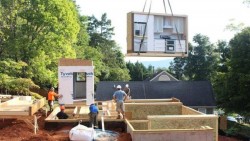A persistent shortage of construction workers across the US is prompting some of the nation’s largest home builders to experiment with a model they once derided: factory production.
KB Home last month unveiled a model home equipped with an energy-efficient kitchen and a rotating audiovisual wall that serves either as a television or video conferencing system for two adjoining rooms. The high-end, hi-tech components all were built in a manufacturing plant to be assembled on-site, requiring far fewer workers in the field.
KB’s concept home represents the latest technological evolution in the residential construction industry, one of the US’s last bastions of outside manual labour.
“Cars, aeroplanes and others have been able to use these same techniques,” said Dan Bridleman, a KB Home senior vice-president.
“Ultimately this is about cost, it’s about efficiency and it’s about speed.”
Home builders have traditionally criticised so-called manufactured or modular housing, in which entire floors of a home are factory-built, trucked to a site and dropped into place with a crane. Purists favour the “stick-built” home — erected from scratch on-site starting with the foundation and piles of timber.
In the US, only about 2-3 per cent of homes built in recent years are classified as modular, according to the national census. In other parts of the world, that share is significantly higher. More than a third of all homes in Austria and Sweden are built using offsite methods, and more than three-quarters of all Japanese detached homes are pre-assembled.
But throughout the US housing recovery, builders have suffered from a shortage of skilled labour, making it tough to meet demand. The number of workers employed in the industry this year is nearly 30 per cent below the 2006 peak and more than 15 per cent below the average during the 2000s, according to the Labour Department.
Toll Brothers was a pioneer among US volume builders, introducing the concept of prefabricated wall panels and roof trusses in the late 1980s. The company has four manufacturing facilities that service more than half of the homes the company builds each year. Executives said that by ¬assembling walls off-site, they can avoid damage that might occur in harsh winter weather conditions and cut down on waste.
“We don’t need as many skilled workers on the job site,” said Rob Parahus, a regional president at Toll Brothers.
With off-site construction, “a four or five-man crew can put together a house in the field that might take a lot longer and a lot more skilled people to put together if they had to build every wall panel on the site”.
Joseph Wheeler, an architecture professor at Virginia Tech University, worked with KB Home to design a kitchen “cartridge” for its concept home that was prefabricated and assembled on site. Mr Wheeler said it made more sense to embed advanced technological features such as climate-control systems into modular components beforehand in a controlled environment.
Mr Wheeler and fellow researchers last year built and sold a house in Charlottesville, Virginia, with their own money using the “cartridge” concept — pre-assembling entire rooms, fitting them into place on-site with cranes and sealing them together. He believes labour shortages and a demand for more technology in homes will force more builders to “rethink conventional construction processes”.
KB Home’s Mr Bridleman expects the company to introduce the prefabricated movable wall from its concept home into markets early next year in southern California. The idea is to create technology-enabled “flex space” within a home: a large living area that can be sectioned off to create a separate bedroom or study with a large monitor embedded in the wall.
He said engineers at the company also were interested in pursuing the kitchen cartridge idea.
Original link - The Australian









